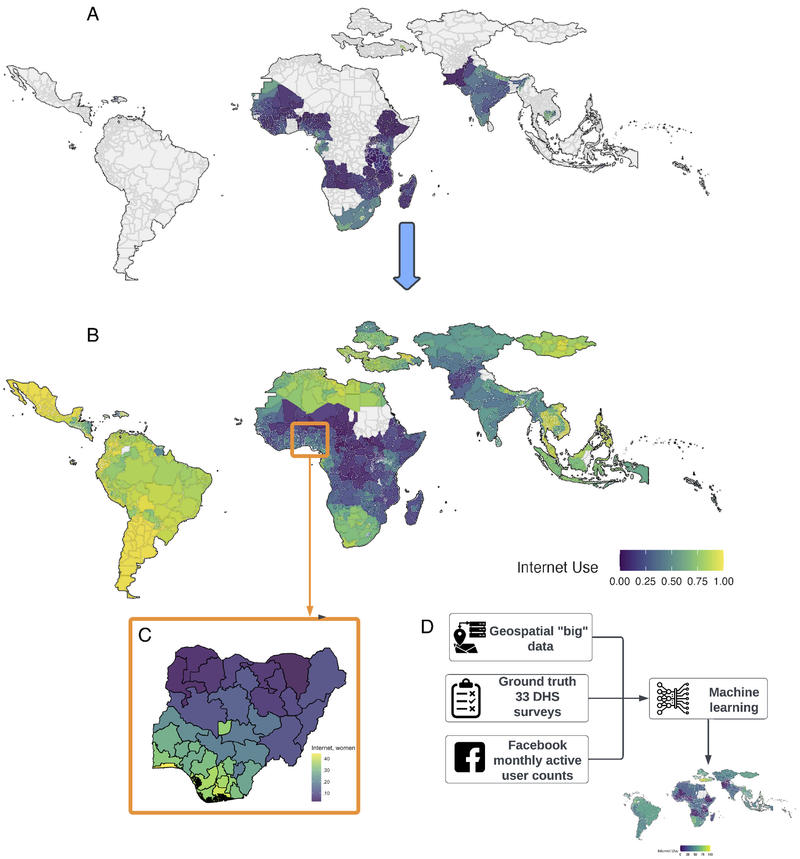A new study led by the University of Oxford has produced a global sub-national dataset on internet use and mobile ownership by gender for 2,075 regions in 117 low- and middle-income countries (LMICs). It finds that women in LMICs continue to face significant barriers to internet access and mobile ownership, compared to men.
The results show that women are 19% less likely to use the internet and 8% less likely to own a mobile phone in LMICs, corresponding to over 320 million fewer women using the internet and 190 million fewer women owning a mobile worldwide.
The unique within-country perspective provided by the data demonstrates that inequalities in internet use between men and women within countries are often as large as those between countries.
Published in the Proceedings of the National Academy of Sciences (PNAS), the paper was co-authored by the Department of Sociology’s Professor Ridhi Kashyap, alongside Oxford’s Dr Casey Breen, Dr Douglas Leasure, Jiani Yan, and Xinyi Zhao; Masoomali Fatehkia from the Qatar Computing Research Institute; and Professor Ingmar Weber from Saarland University.
Reliable quantitative estimates of digital gender inequalities are essential for tracking progress and shaping targeted policies and interventions aligned with the UN’s global sustainable development goals (SDGs). Closing gender gaps in access to digital technologies is a key target under SDG 5 on gender equality, while digital literacy forms an essential component of SDG 4, which focuses on the right to education.
Professor Kashyap explained:
Although there is growing recognition of the importance of digital technologies for social and development outcomes, data – especially at a sub-national level – on who has access to these technologies is sparse. However, sub-national estimates are essential for monitoring gaps within countries and implementing targeted interventions.
This study uses a novel machine-learning approach to estimate levels of internet use and mobile phone ownership among men and women across 117 LMICs between 2015 and the present.
The model drew on aggregate Facebook user counts, geospatial data, development indicators, and population composition data, and was calibrated using household survey data from 33 countries. The data from the study can be accessed here.

Description of the general approach. (A) The 33 countries with available ground truth data. (B) Model-based estimates of internet adoption for women across 117 countries for January 2025. (C) Enlargement of estimates for Nigeria. (D) Illustration of inputs to the machine learning models for predicting digital adoption indicators.
Dr Casey Breen said:
Our results revealed large disparities in digital adoption between and within countries and demonstrated the promise of this method for real-time monitoring of global SDGs.
In particular, digital gender gaps varied greatly within countries – in over 40 countries, the gap between the regions with the highest and lowest female internet adoption exceeded 30 percentage points.
For example, in Nigeria – a country with one of the largest sub-national disparities in women’s internet adoption – as of January 2025, over 70% of women in the relatively affluent and urban state of Lagos had accessed the internet, compared to less than 20% of women in the rural state of Kebbi.
Across all digital indicators of adoption levels and gender gaps, the largest sub-national disparities are concentrated in Africa. Outside of Africa, large sub-national disparities also occur in India and Pakistan.
Professor Kashyap added:
This paper underscores the importance of sub-national data for a more complete understanding of inequality in digital adoption, especially in countries with the lowest overall levels of human development.
Our estimates provide a valuable lens for researchers and policymakers through which to assess areas that stand to benefit from the increasing rollout of digital programmes within global development policies, as well as those at risk of being left behind.
The paper’s innovative methods enabled researchers to track how digital inequalities are changing in real-time as they are shaped by external socio-political events – as indicated by the context of Afghanistan, where results detected a decrease in women’s internet adoption after the 2021 resurgence of the Taliban.
This research adds to growing evidence that machine learning, combined with emerging data sources, can offer large-scale, cost-effective, and complementary methods for measuring social and economic trends alongside traditional survey and field research.
The research was conducted as part of the Digital Gender Gaps project based at the University of Oxford (www.digitalgendergaps.org).